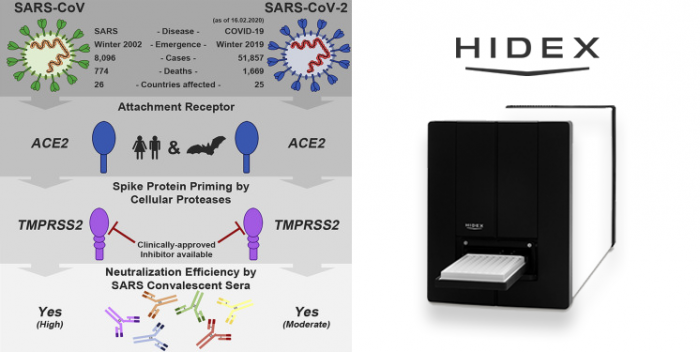Studying #COVID19 around the world using the Hidex Sense microplate reader
02/04/2020

Hidex Sense microplate reader used to research mechanisms, diagnostics, and therapeutic targets of SARS-CoV-2
As the global COVID-19 (also known as SARS-CoV-2) crisis continues to unfold, it’s important to recognise the scientists behind the vital studies investigating the virus. The current pressing task of epidemiologists and virologists around the world is studying the mechanisms and transmission of SARS-CoV-2, to better understand the virus whilst revealing therapeutic targets.
In two recent publications, the Hidex Sense microplate reader was used to investigate SARS-CoV-2. The first study (Hoffmann et al., 2020) sought to understand the current coronavirus in relation to the SARS-CoV virus, which emerged in winter 2002. Through utilising luminescence capabilities on the Hidex Sense, the group quantified cell viability (cell death) of Calu-3 cells that are treated with camostat mesylate.
By unravelling cellular factors used by the virus for entry, the paper demonstrated that ‘SARS-CoV-2 uses the SARS-CoV receptor ACE2 for entry and the serine protease TMPRSS2 for S protein priming’ (Hoffmann et al., 2020). This revealed a potential treatment option of using a TMPRSS2 inhibitor that has been previously clinically approved. Furthermore, the paper gave insight into using sera from recovering SARS-CoV patients to cross-neutralise SARS-CoV-2 entry as a method of treatment. Overall, the paper highlighted important commonalities between SARS-CoV and SARS-CoV-2, outlining a path for future antiviral intervention.
The second study (Woo et al., 2020) outlines their solution for a fast and simple method to identify the virus. Woo et al. (2020) suggests a nucleic acid method for the diagnosis of SARS-CoV-2; by detecting pathogen RNAs with high sensitivity and specificity, using a SENsitive Splint-based one-step isothermal RNA detection (SENSR) method.
The Hidex Sense was used for rapid RNA detection using this SENSr assay method, using the fast and sensitive fluorescence available within the instrument. The results of the paper suggested the SENSR method is a highly sensitive and effective form of diagnosis for the current epidemic of SARS-CoV-2.
References
- Hoffmann, M., Kleine-Weber, H., Schroeder, S., Krüger, N., Herrler, T., Erichsen, S., Schiergens, T., Herrler, G., Wu, N., Nitsche, A., Müller, M., Drosten, C. and Pöhlmann, S., 2020. SARS-CoV-2 Cell Entry Depends on ACE2 and TMPRSS2 and Is Blocked by a Clinically Proven Protease Inhibitor. Cell,.
- Woo, C., Jang, S., Shin, G., Jung, G. and Lee, J., 2020. Sensitive one-step isothermal detection of pathogen-derived RNAs.